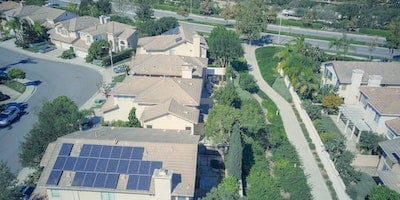
What is Net Metering and How it Works
Learn what net metering is and what it means for your solar system.
Is solar right for you?
Find out in less than a minute.
Net Energy Metering, is that how you start racking in cash from the utility company?
Well, not quite. Let's go over how it works, the pros and cons, and if it's available in your state.
What is Net Energy Metering (NEM)?
Net metering is a billing mechanism that allows your solar panels to give you a credit for putting electricity into the grid. When your solar panels produce more electricity than you can use, the leftover energy goes back to the grid. You get credit for the energy you produce.
For example, if your solar panels generated 1,000 kWh in a month and your home used 900 kWh you would receive a credit for the difference.
Net metering can make solar panels significantly more cost-effective since it allows you to build up credits and ideally eliminate your electric bill.
How does Net Metering Work?
Energy Generated vs Energy Consumed
An average home, without solar, is only charged for the energy it consumes with a regular electricity meter. Net metering refers to the different type of metering system that considers both the energy consumed and generated. The home owner is then charged or credited for the net difference in energy.
Below is an image of what the energy consumption profile may look like in your average home. This of course is different for everyone and your routine.
The horizontal axis is the hours in a day. The vertical axis in the energy consumed.
The typical home has a low night time energy baseline with most appliances turned off. In morning, people awake and get ready for the day before heading to work. During the middle of the day, the energy could drop down similar to nighttime loads if no one is home or you could see some energy generation is the HVAC system is on to keep the home from getting too hot or too cold.
After 5pm, residents return home, turning on lights and appliances before heading back to bed.

Below is an image of a typical solar system energy production profile on a sunny day in the United States.

Net Energy Metering is the process of looking at both of these profiles together, as shown in the image below.

The energy generated by the solar system is only consumed during the hours the sun is up.
During the middle of the day, when less energy is being consumed but energy is being generated, there is excess energy generated. This is called energy over-generation. The orange area in the image is the amount of energy that is sent back to the utility company. This can also be referred to as energy going back to the grid.
Inversely, when your solar panels aren’t able to produce enough electricity to meet your demand you pull electricity from the grid. This is still happening during the hours when the sun is not up (the green area).
At the end of a cycle, the utility company calculates how much energy you put into the grid versus how much you took out. If you generated more than you consumed you receive credits on your bill.
Unfortunately, Net Metering does not mean you'll be getting fat stacks in the mail.
While utilities do not send you a check or pay you directly, it is possible not to pay anything on your utility bill. It is all dependent on the net difference between energy generated and energy produced.
Utility Rates: How many credits can you expect?
This is all dependent on where you live, who your utility provider is, and what NEM rate you are on.
The utility company consumption rates are dependent on grid demand. This means, if your energy usage is high, you'll be charged more. It may also change based on season, day of the week, and time of day.
Energy production credits are not given in the same way you are charged. So, don't expect to receive the same amount of bill credits for the on-site renewable energy as the energy you are consuming from the grid. In general, generation credits are provided at a market rate, which is a fraction of what you are being charged.
Do the Solar Credits Expire?
It depends.
The image below is the latest map on the DSIRE website as of March 2023. It is not up to date comparing to the map later on in the article showing which states have Net Metering. However, this gives you an idea of what may still be current in some states.
While some states the credit don't expire, some do. It also shows which are required to offer market rates for solar credits and some don't.

Does Net Metering Only Apply to Solar Customers?
No. A more accurate term may be Renewable Energy Credits. Although we recommend checking with your state and utility company on different requirements for your energy generation system, net metering is available for other types of renewable energy systems.
The Future of Solar Credits
We all know the price of energy is increasing. This is due to several factors. Too many to get into in this article today. Regardless, the main two reasons are we have a growing global population and a demand for energy.
At the same time, the solar market is growing. This is good and bad for you making the decision to purchase a solar system for your home.
More solar is helping the grid with rising energy demands. However, as more people get solar, the utility will have less incentive to provide credits to you. In the past 10 years, we have seen the cost of solar credits decrease. Just like any other market, the more prevalent a commodity is, the lower the cost becomes.
While this is important to keep in mind for this long term investment. As of today, 2023, solar power is a positive experience for most homeowners.
Benefits of Net Metering
Net metering has benefits for your pocketbook and the energy grid.
Payoff Your Solar Panels Faster
The bill credits you receive save you money out of your pocket when your solar panels aren’t producing electricity. While you aren’t getting paid directly, the bill credits make solar panels much more cost-effective.
Reduce (or Eliminate) Your Electric Bill
If you are able to produce enough electricity it means that you could essentially eliminate your electric bills.
Environmental Benefits
Most Power Plants today still generate electricity with coal or natural gas.
By producing your own electricity, you are indirectly putting less carbon dioxide into the atmosphere.
Reduce Stress on the Energy Grid
As the population increases utilities struggle to meet the energy needs of homes and businesses. By installing solar panels tied to the grid you are helping reduce stress on the grid by pumping electricity into it rather than pulling energy out of it.
Encourages Solar Adoption
Overall, the solar power market is growing. Solar panels cost less today than they ever had. Beyond solar credits, there are additional state and federal incentives to install a solar energy system.
Downfalls of Net Metering
Limited Availability in Some Areas
Net Metering is not available everywhere. In the next section, there is a map showing where Net Metering is available.
Complicated Regulations and Rates
In order to receive solar credits, the solar system must be connected to the grid. This means tying the system to your electrical panel and getting the utility company involved.
Depending on where you live, the regulations, permits, fees, and inspections vary dramatically. This may be a discouraging process to go through.
The regulations and rates have also been changing. This not only makes it hard for the average consumer to keep up with but also the solar installers in providing the information. Looking for accurate and up-to-date information is hard and brings uncertainty to the future.
Is Net Metering Available Everywhere?
No. Although, it is growing. 39 states plus Washington DC, American Samoa, Guam, Porto Rico, and the US Virgin Islands currently have mandatory Net Metering rules.
While not all states have mandated net metering many local utilities have net metering policies in some form. We recommend using the database on DSIRE to research what’s available in your area.

Written by Thad Warren
Thad is a native Texan who has worked in the energy industry for just over 5 years.
Connect
Recent Posts
Compare Texas Solar Buyback Plans
Discover the best Texas solar energy buy back programs for 2025! Compare rates, terms, and providers to maximize savings and make the most of your solar investment.
September 2025

7 minutes

How Efficient Are Solar Panels
How efficient are solar panels compared to other types of energy generation?
March 2023

4 minutes

What You Need To Know About The California Solar Mandate
Learn how the California Solar Mandate changes how new homes are built.
July 2023

4 minutes


